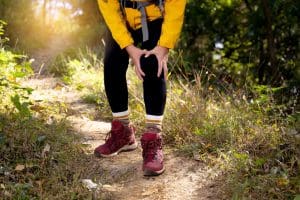 Are you familiar with the discomfort of experiencing knee pain during hiking expeditions? For outdoor enthusiasts who cherish nature and the adventures it offers, encountering knee pain can be immensely frustrating. Continue reading to learn what to do in order to prevent and manage knee pain for future hiking endeavors.
Are you familiar with the discomfort of experiencing knee pain during hiking expeditions? For outdoor enthusiasts who cherish nature and the adventures it offers, encountering knee pain can be immensely frustrating. Continue reading to learn what to do in order to prevent and manage knee pain for future hiking endeavors.
Are you an avid hiker who loves spending time in nature, but knee pain has been putting a damper on your adventures? Hiking can be a challenging activity for your knees, as it involves repetitive stress on the joints and uneven terrain. However, with the right precautions and practices, you can enjoy hiking without knee pain. Here’s some helpful tips to keep your knees pain-free during your hiking adventures.
What causes knee pain while hiking?
Knee pain is a common complaint among hikers, and it can be caused by a variety of factors. The most common cause of knee pain while hiking is overuse. This can happen when you hike for too long, too often, or too hard. Overuse can lead to inflammation, which can cause pain and swelling in the knee joint.
Another common cause of knee pain while hiking is improper alignment. When your knees are not aligned correctly, it can put pressure on the joint and cause pain. This can happen if you have weak muscles, poor posture, or if your shoes or hiking boots are not the right fit.
Here are some possible reasons for knee pain while hiking and some tips on how to manage it:
- Overuse or strain: Hiking involves repetitive movements of the knees, such as bending, flexing, and weight-bearing. Overdoing it or pushing too hard can lead to overuse or strain on the knee joints and surrounding muscles, tendons, and ligaments, resulting in pain. To prevent this, it’s important to gradually increase your hiking intensity and duration, and take breaks when needed. Wearing proper hiking shoes that provide good support and using hiking poles to reduce stress on your knees can also help.
- Knee osteoarthritis: Osteoarthritis, a degenerative joint disease, can cause knee pain during hiking. The cartilage in the knee joint can wear down over time, leading to pain, stiffness, and swelling. If you have a history of knee osteoarthritis or other joint conditions, it’s important to take precautions while hiking. Using knee braces or sleeves, and choosing trails with moderate intensity and even terrain can be beneficial. Talk to your healthcare provider for advice on managing knee osteoarthritis during hiking.
- Muscle imbalances: Weak or imbalanced muscles around the knees can affect the alignment and stability of the joint, leading to pain during hiking. Strengthening exercises that target the muscles around the hips, thighs, and calves, such as squats, lunges, and calf raises, can help improve knee stability and reduce the risk of pain. Consulting with a physical therapist or a certified fitness professional can provide guidance on appropriate exercises and techniques.
- Improper gear or technique: Wearing ill-fitting shoes, using heavy backpacks, or having poor hiking technique can also contribute to knee pain. It’s essential to invest in proper hiking gear, including well-fitting shoes with good ankle support and traction, and using a backpack that fits properly and distributes weight evenly. Maintaining proper hiking technique, such as avoiding sudden twists or pivots, taking small steps, and using correct body mechanics, can also prevent knee pain.
- Pre-existing conditions: If you have pre-existing knee conditions such as ligament tears, meniscus injuries, or tendonitis, hiking may exacerbate the pain. It’s important to consult with your healthcare provider or orthopedic specialist for appropriate recommendations and precautions based on your specific condition.
My knee hurts when going downhill?
If you experience knee pain specifically when going downhill while hiking, it could be due to various reasons, such as increased impact and strain on the knees during downhill descents, altered body mechanics, or overloading of certain knee structures. Some potential causes of knee pain when going downhill during hiking could include:
- Patellofemoral pain syndrome: This condition occurs when the patella (kneecap) doesn’t track properly over the femur (thigh bone), causing pain and discomfort, particularly during activities that involve bending the knee, such as going downhill.
- Meniscus tear: The meniscus is a C-shaped cartilage in the knee joint that provides cushioning and stability. Tears in the meniscus can occur due to sudden twisting or repetitive stress, and may cause pain, particularly during downhill activities.
- Osteoarthritis: Knee osteoarthritis is a degenerative joint condition that can cause pain, stiffness, and discomfort in the knee joint, particularly during weight-bearing activities such as hiking downhill.
- IT (iliotibial) band syndrome: The IT band is a thick band of connective tissue that runs along the outside of the thigh and can become inflamed and painful with repetitive motions, such as those involved in downhill hiking.
- Ligament injuries: Injuries to the knee ligaments, such as the anterior cruciate ligament (ACL) or medial collateral ligament (MCL), can cause knee pain and instability, and may be exacerbated during downhill activities.
Click here to continue reading
Original article published on trailhiking.com.au








